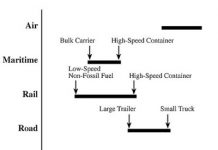You are at a cocktail party somewhere, and, after joining a random group of revelers, you utter the following words: “If I say alternative fuel, what’s the very first thing that comes to mind…don’t even think about it, just answer!��? If this fiesta was taking place last night, 9 folks out of 10 would have answered “ethanol��?. The remaining 10% would have probably made-up a mix-bag of “biodiesel��?, “hydrogen��?, and, in extremely rare cases, “synthetic fuels��?, also known as synfuels. Ten years from now, I bet you anything that far more than 10% of the general public will be thinking synfuel when they hear the words “alternative fuel”. Synfuels are liquid fuels made from coal, natural gas or biomass. They can be used to power the same kind of applications that currently utilize gasoline or diesel, most notably cars. Today I want to focus on one particular sub-type of synfuel – namely coal-based synfuel or coal-to-liquids (CTL). An article on CTL hit the mainstream newswire on Monday, casting some light on this little-known-yet-promising fuel source. Investing in CTL: 4 Things You Should Know The aim of this post is not to go over the whole process behind making CTL, thus me providing some links above for those who are curious about the science behind CTL. What I want to do here is to give you nuggets of useful information that will provide a good starting point should you decide to look at this seriously as an investment option. Here are 4 main things you should know: A) There’s lots of coal around. The Energy Information Agency (EIA) estimates that, at the 2002 production rate, there’s about 200 years worth of coal left in the global ground; 26% is in the US, 23% in the Former Soviet Union and 12% in China. Like oil, recoverable reserves will likely increase as new extraction processes are brought on stream. However, like oil, production rates are going to increase massively as demand from booming economies like China and India picks up. B) I’ve come across a couple of different estimates of crude oil price floors required to make CTL operations in the US profitable. Estimates typically range from $40/barrel to $45/barrel. You thus have to be an energy bull to want to invest in CTL in the US. Apparently, the Chinese are running operations that are economical at $25/barrel. On a related note, I recently came across an interesting article in the September 2006 edition of Chadbourne & Parke’s Project Finance Newswire (PDF, see article on p. 24) discussing, among other things, the energy price risk associated with investing in CTL from a project finance standpoint. C) CTL fuel burns much cleaner than conventional fuels, as a lot of the dirty stuff is removed during the production process. This means that, under certain favorable regulatory scenarios, CTL could hold some form of a ‘clean’ premium over gasoline at the pump (e.g. lower taxes). However, producing synfuel from coal generates large amounts of carbon dioxide, and carbon dioxide could become regulated at the federal level before most proposed US CTL operations are fully up-and-running. This could add certain costs at the front end of the production process that would nullify back end benefits. D) Politicians and the military like CTL. I won’t discuss the military as I don’ know too much about it, other than the fact they have been running some tests and seem to like the idea of not having to rely on hostile countries to power their fighter jets. Politicians like CTL for the same reasons they like ethanol: (a) there’s a rural job-creation angle in an industry otherwise seen as on the wane, (b) it’s an easy sell to voters concerned about the security implications of sourcing a large part of America’s energy from unfriendly nations, and (c) soft environmentalists, under the right conditions (e.g. carbon capture at CTL plants), will embrace CTL because of its overall cleaner profile. If you want specifics on the existing and proposed government incentives for CTL, go to the EIA’s most recent Coal News and Markets page and scroll down to the section called “Coal Technology��? towards the end. Under the sub-heading “Coal-to-Liquids Project Financing��?, there is a short discussion on this topic (sorry for not being able to provide a direct link to the section, the page doesn’t allow for it). 3 CTL Stocks The article on CTL discussed initially lists 3 companies who are banking on a bright future for coal-based synfuel: Headwaters [NYSE:HW], Syntroleum Corp [NASDAQ:SYNM], and Rentech [AMEX:RTK].  Of the 3 companies, Headwaters is the only 1 with positive earnings, although I suspect it’s not from its CTL operations. The stock has had a terrible year, and it is currently trading down about 40% from its 52-week high of $40.19. Earnings year-on-year are down nearly 38%. Nevertheless, analysts covering the stock seem confident that 2007 EPS will be markedly higher than 2006 EPS.
Of the 3 companies, Headwaters is the only 1 with positive earnings, although I suspect it’s not from its CTL operations. The stock has had a terrible year, and it is currently trading down about 40% from its 52-week high of $40.19. Earnings year-on-year are down nearly 38%. Nevertheless, analysts covering the stock seem confident that 2007 EPS will be markedly higher than 2006 EPS.  Syntroleum Corp hasn’t exactly had a great year either, and analysts don’t expect the firm to become profitable for a few more years. Syntroleum is the company with the most important exposure to the military.
Syntroleum Corp hasn’t exactly had a great year either, and analysts don’t expect the firm to become profitable for a few more years. Syntroleum is the company with the most important exposure to the military.  Rentech is the company I am most familiar with, as I seriously investigated it as a potential investment last summer. In the end, I decided not to buy at and I’m happy I made that choice. Rentech has a very interesting project pipeline, and is probably the closest thing to a CTL pureplay there is. I might look it again in the near future. After deciding not to purchase Rentech, synfuels fell off my radar screen, and with good reason. There hasn’t been an exciting synfuel story yet, and investor attention (but not mine!) has been squarely on ethanol. I must say that reading that article has rekindled my interest, and CTL is definitely something that I’m going to start paying more attention to. To conclude, if you want a good, safe way to get some exposure to CTL, have a quick look at the South African company Sasol [NYSE:SSL]. When South Africa was under a trade embargo because of its apartheid regime, Sasol perfected CTL technology to keep South African cars running, and the company is now busy developing that side of their business in places like China.
Rentech is the company I am most familiar with, as I seriously investigated it as a potential investment last summer. In the end, I decided not to buy at and I’m happy I made that choice. Rentech has a very interesting project pipeline, and is probably the closest thing to a CTL pureplay there is. I might look it again in the near future. After deciding not to purchase Rentech, synfuels fell off my radar screen, and with good reason. There hasn’t been an exciting synfuel story yet, and investor attention (but not mine!) has been squarely on ethanol. I must say that reading that article has rekindled my interest, and CTL is definitely something that I’m going to start paying more attention to. To conclude, if you want a good, safe way to get some exposure to CTL, have a quick look at the South African company Sasol [NYSE:SSL]. When South Africa was under a trade embargo because of its apartheid regime, Sasol perfected CTL technology to keep South African cars running, and the company is now busy developing that side of their business in places like China.








For those interested in the technology behind CTL (Coal), GTL (Gas) and BTL (Biomass) – to liquid technologies might wish to check out the following recent article published online in the “Green Chemistry” chemical journal (from the Royal Society of Chemistry):
Environmentally friendly refining: Fischer–Tropsch versus crude oil
Arno de Klerk
Fischer–Tropsch Refinery Catalysis, Sasol Technology Research and Development, PO Box 1, Sasolburg, 1947, South Africa
DOI: 10.1039/b614187k
Personally, I think Arno claims somethings which are a little controversal. Although being from SALSOL this is probably to be expected – seeing many of the virtues without the flaws. I admit however – given Hubbert’s Peak – there really isn’t any other solution in the long term – on economies of scale terms alone.
Controversy including – That syncrude processes are more environmentally friendly than crude oil refining…
He doesn’t mention the larger energy PRIMARY ENERGY INPUT to generate the syncrude relative to crude-oil refining … therefore greater CO2 emissions earlier in the whole lifecycle?.
I think given new catalysis and chemical enginnering that the process generally has a commercial future – as long as the industry in general is not affraid to be brave with new technology as a whole. Only “diminishing” subsidies from governments will encourage this – to minimise risks to a notoriously comservative industry. In terms of climatic change – it is imperative that some risks are taken now however. Indeed if legislation goes forward as it has been – then theres a further driver to be in the “driving seat” with these technologies development!
I also think given automotives will become more efficient running on hybrid Fuel-cell / internal combustion power; then there certainly is a market here and the credentials of SYNTHFUELS are enhanced given changes in Automotive technologies are implemented in parallel. Ultimately, using coal in this way as a feed is a stop gap measure – only biomass is truely a sustainable and appropriate feedstock in the future for society generally.
Could these companies be using CTL as an initator for there other endeavours in “alternative energies”? I truely hope so! And that CTL isn’t the end of the road – but a new road into biomass technologies….
There is more information mentioned about liquid fuels.I think this will be useful for the future projects.